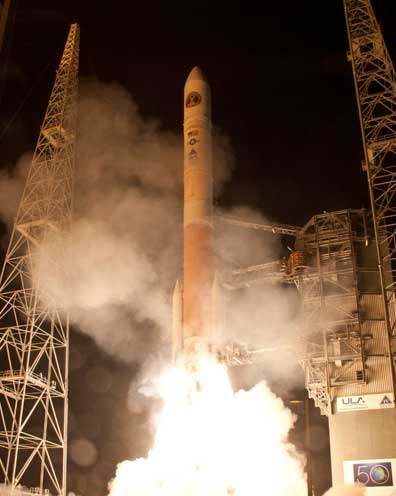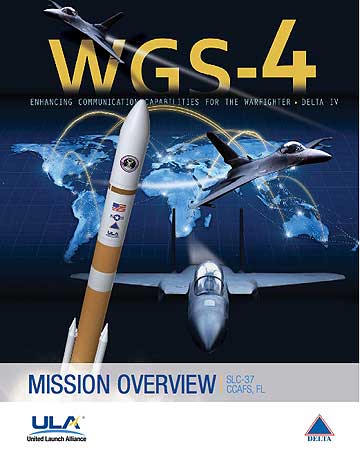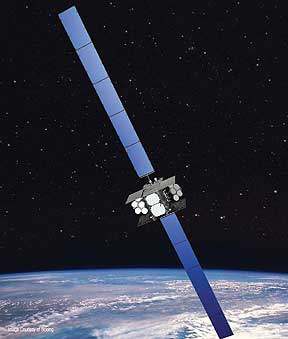
Photo by Pat Corkery, United Launch Alliance
Evening Of Launch Update...From Boeing — Signals Received
Boeing [NYSE: BA] has received the first on-orbit signals from the fourth Wideband Global SATCOM (WGS) satellite it is delivering to the U.S. Air Force. The signals indicate that WGS-4, the first in the Block II series, is healthy and ready to begin orbital maneuvers and operational testing.
WGS-4 launched on a United Launch Alliance Delta IV vehicle today at 7:38 p.m. Eastern time from Cape Canaveral Air Force Station. Controllers confirmed initial contact with the spacecraft 58 minutes later at 8:36 p.m. Eastern time at a ground station in Dongara, Australia. Boeing's Mission Control Center in El Segundo, Calif., confirmed that the satellite is functioning normally.
"WGS-4 continues Boeing's commitment of supporting the Air Force's mission of delivering critical communications to warfighters," said Craig Cooning, vice president and general manager of Boeing Space & Intelligence Systems. "The company will remain focused, committed and dedicated to this mission as we continue to build the WGS series of satellites."
Statement from United Launch Alliance...
Cape Canaveral Air Force Station, Florida, (Jan. 19, 2012) – A United Launch Alliance Delta IV rocket carrying the Wideband Global SATCOM-4 (WGS-4) satellite for the United States Air Force lifted off from Space Launch Complex-37 here at 7:38 p.m. EST today. This is ULA’s first launch of the year and marked the 18th launch of the Delta IV vehicle.
“We are honored to have worked closely with our Air Force and mission partners to enable today’s successful launch of the WGS-4 satellite. WGS-4 will provide important capabilities to the soldiers, sailors, airmen and marines protecting our freedoms around the world,” said Jim Sponnick, ULA vice president, Mission Operations. “This mission begins the most aggressive launch campaign in the history of the EELV program, with nine national security and two NASA launches scheduled this year.”
This mission was launched aboard a Delta IV Medium-plus configuration vehicle using a ULA single common booster core powered by a Pratt & Whitney Rocketdyne RS-68 main engine, along with four Alliant Techsystems GEM 60 solid rocket motors. The five-meter diameter upper stage was powered by a PWR RL10B-2 engine with the satellite encapsulated in a five-meter diameter composite payload fairing.
“WGS was the first of the new constellation of satellites to integrate and launch on both the Delta IV and Atlas V vehicles — the first two on Atlas and now, with WGS-4, the second one on our Delta IV launch system,” said Sponnick. “Our ability to integrate and launch satellites successfully and efficiently on two launch systems to provide operational flexibility was a primary reason that ULA was formed.”
Wideband Global SATCOM provides anytime, anywhere communication for the warfighter through broadcast, multicast, and point to point connections. WGS is the only military satellite communications system that can support simultaneous X- and Ka-band communications.
ULA's next launch is the Atlas V launch of the United States Navy’s Mobile User Objective System-1 (MUOS-1), scheduled for February 16, 2012 from Space Launch Complex-41 at Cape Canaveral Air Force Station, Florida. Go Delta! Go WGS!
The following are minute-by-minute sequences as the rocket leaves the pad...currently... and anticipated stages into the remainder of the mission, today, January 19.
The two-burn mission flies an easterly trajectory from SLC-37 with an approximately 101-degree flight azimuth. The separation event releases the WGS-4 satellite into a supersynchronous transfer orbit with a 237-nautical mile (nmi) perigee, an apogee radius of approximately 36,108 nmi, and an approximately 24 degree inclination.
Launch began with RS-68 engine ignition approximately 5.5 seconds before liftoff (T-5.5 seconds). SRM ignition takes place at T-0.02 seconds after telemetry indication of healthy RS-68 startup.
Liftoff occurs at T+0.0 seconds. Shortly after the vehicle clears the pad, it performs its pitch/yaw/ roll program. Maximum dynamic pressure occurs approximately 50 seconds into flight.
The SRMs burn out at approximately T+94 seconds, and are jettisoned in pairs at T+100 and 103 seconds. Payload fairing jettison takes place at approximately 207 seconds; about 40 seconds prior to main engine cutoff (MECO). MECO occurs at approximately 247 seconds.
DCSS separation is about 6 seconds after MECO. DCSS main engine start occurs 13 seconds after the separation event. At approximately 20 minutes into the mission, the first second stage engine cutoff (SECO-1) occurs and DCSS has achieved its parking orbit.
After an 8-minute coast phase, DCSS reorients itself for restart. Restart ignition takes place approximately 28 minutes into the mission and lasts about 3 minutes. After SECO-2, DCSS re- orients its attitude for the separation event. The WGS-4 spacecraft separates about 41 minutes after launch. The turn to Collision and Contamination Avoidance Maneuver (CCAM) attitude begins about 3 minutes after the separation event. The DCSS mission ends 79 minutes after launch after blowdown of the propellant tanks and burn off of residual hydrazine.
Cape Canaveral Air Force Station, Florida, a United Launch Alliance Delta IV stands ready for launch at Space Launch Complex-37 with the Air Force's Wideband Global SATCOM (WGS-4) payload. Launch is scheduled for today, January 19 at 7:38 p.m. EST. Wideband Global SATCOM provides anytime, anywhere communication for the warfighter through broadcast, multicast and point-to-point connections.
Everything is proceeding well with the countdown in preparation for the launch at 7:38 p.m. EST tonight. Fueling operations are continuing. The forecast is still showing a 95 percent chance of favorable weather conditions for launch.

WGS Mission
The Wideband Global SATCOM (WGS) satellites are the key elements of a high-capacity system that provide a quantum leap in communications capabilities for the warfighter.
WGS supports the Department of Defense's warfighting information exchange requirements, enabling execution of tactical command and control, communications, and computers; intelligence, surveillance, and reconnaissance (C4ISR); battle management; and combat support information. WGS also augments the current Ka-band Global Broadcast Service (on UHF F/O satellites) by providing additional information broadcast capabilities.
WGS is the DoD's highest-capacity satellite communications system. Each WGS satellite can route 2.1 to 3.6 Gbps of data — providing more than 10 times the communications capacity of the predecessor DSCS III satellite. Using reconfigurable antennas and a digital channelizer, WGS also offers added flexibility to tailor coverage areas and to connect X-band and Ka-band users anywhere within the satellite field of view. The system provides tremendous operational flexibility and delivers the needed capacity, coverage, connectivity and control in support of demanding operational scenarios. Boeing was awarded the WGS initial contract in January 2001 for the first three satellites plus the associated ground-based command and control elements. Integrated logistics, training, and sustaining engineering support are also provided by Boeing.
The U.S. Air Force MILSATCOM Systems Directorate at Los Angeles Air Force Base (AFB) is the WGS customer. The first WGS three satellites, which constitute Block I, are all on-orbit and are meeting or exceeding all operational requirements. WGS-1 was placed into service over the Pacific Ocean region in April 2008. WGS-2 was placed into service over the Middle East in August 2009.
WGS-3 went into operations over Europe and Africa in June 2010. Under a Block II contract, awarded in October 2006, three more satellites, WGS-5, and -6, are being built to meet the warfighter's evolving SATCOM bandwidth requirements. Launches are scheduled in FY 2012 and 2013. The Block II satellites add a radio frequency bypass capability designed to support airborne intelligence, surveillance and reconnaissance platforms requiring ultra-high bandwidth and data rates demanded by unmanned aerial vehicles. In August 2010, the Air Force authorized Boeing to begin work on the WGS-7 satellite as part of the WGS Block II Follow-on contract. In September 2011, the Air Force authorized additional funding to the Block II Follow-on contract for full production, launch and on-orbit activation of the WGS-7 satellite and procurement of long-lead materials for WGS-8. The authorization also included options for the full production, launch and on-orbit activation of WGS-8 and WGS-9. The U.S. Air Force exercised options on WGS-8 in December 2011 and WGS-9 in January 2012. Boeing remains in active discussions with the Air Force on ways to modify the WGS satellites and provide even more capability for the warfighter.

The WGS-4 (mock up shown here) satellite is an approximately 13,200-lb communications satellite. WGS supports communications links in the 500 MHz range of the X-band and 1 GHz range of the Ka-band spectra. WGS can filter and route up to 4.875 GHz of instantaneous bandwidth. WGS-4, the first Block II satellite, includes a high-bandwidth RF bypass capability in addition to the previous capabilities provided by the Block I satellites. Depending on the mix of ground terminals, data rates, and modulation schemes employed, a WGS satellite can support data transmission rates between 2.4 and 3.6 Gbps. WGS has 19 independent coverage areas that can be positioned throughout its field of view. This includes eight steerable/shapeable X-band beams formed by separate transmit/receive phased arrays; 10 Ka-band beams served by independently steerable diplexed antennas (three with selectable RF polarization); and transmit/receive X-band Earth-coverage beams. WGS can tailor coverage areas and connect X-band and Ka-band users anywhere within its field of view.
Four Army Wideband Satellite Operations Centers (WSOC) provide command and control of WGS. Each Global SATCOM Configuration and Control Element (GSCCE) has the capability to control up to three satellites at a time, using X-band or Ka-band telemetry and command links. Spacecraft platform control is accomplished by the 3rd Space Operations Squadron at Schriever Air Force Base in Colorado Springs, Colorado, using WGS mission-unique software and databases.
Support technologies for WGS include the xenon-ion propulsion system (XlPS), which is 10 times more efficient than conventional bipropellant systems, highly efficient triple-junction gallium arsenide solar cells, and deployable radiators with flexible heat pipes. Four 25-cm XlPS thrusters remove orbit eccentricity during transfer orbit operations. The thrusters also used to perform orbit maintenance and any required station-change maneuvers during the mission’s life. The triple-junction gallium arsenide solar cells provide on-orbit electrical power for the spacecraft. The deployable radiators’ flexible heat pipes provide increased radiator area, resulting in a cooler, more stable thermal environment for the spacecraft.

